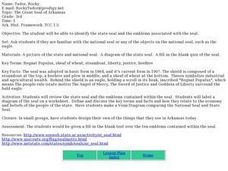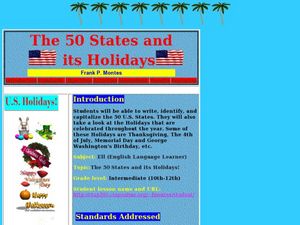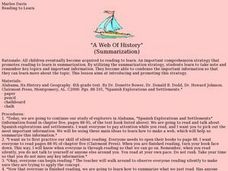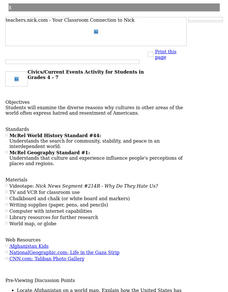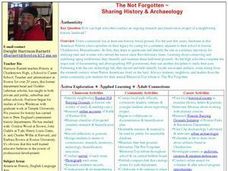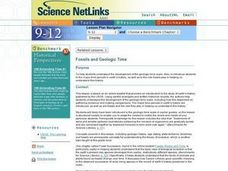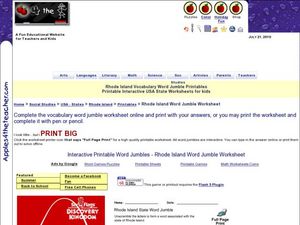Curated OER
Touring My County
Second graders research important events that occurred in their counties for each year they have been alive. They, in groups, categorize these events and develop notes to be used in the writing of an autobiography.
Curated OER
Massachusetts Oral History Project on the Great Depression
Eleventh graders conduct interviews with a relative or a family friend who lived in Massachusetts during the Depression. They write an essay based on the interview that shows an intimate portrayal of how the lives of the individuals who...
Curated OER
Inventions Change the World: The Enigma Machine
Third graders explore WWII by analyzing technological advances. In this invention instructional activity, 3rd graders discuss the use of the Enigma machine which decoded private German messages that communicated with U-boats. Students...
Curated OER
Great Seal of Arkansas
Students identify the state seal of Arkansas and the emblems associated with the seal. They use a Venn diagram to compare the national seal with the state seal.
Curated OER
Who Started World War I?
Young scholars debate which power was responsible for the outbreak of World War I. In this cause and effects lesson plan, students research the causes of the outbreak of World War I on ProQuest in preparation for a (limited) reenactment...
Curated OER
The 50 States and its Holidays
Though the format of this ELL lesson is confusing (the standards listed are for plate tectonics, yet the objectives are for American geography and holidays), a teacher could glean some ideas from the main idea. Here, pupils complete a...
Curated OER
Hidden in Plain View: History Standard Two and the Underground
Eighth graders create a quilt based on the Underground Railroad quilt code from the book Hidden in Plain View: A Secret Story of Quilts and the Underground Railroad.
Curated OER
Examining the African American Role in New Haven History: Pride in the Past? Hope for the Future
Fifth graders examine the role of African-Americans in New Haven, Connecticut. Using two maps, they compare and contrast the differences in the town from the past to today. In groups, they use the internet to research the contributions...
Curated OER
Fifth Grade Music: An Ancient Round, Vocal Music in the Renaissance
Fifth graders sing the melody for Sumer Is Icumen In, in unison and as a two-part round. They listen to a madrigal from Renaissance Italy and a lute song from Elizabethan England.
Curated OER
A Web of History -- Summarization
Students listen to a reading selection about explorers in Alabama called "Spanish Explorations and Settlements." They listen for main ideas of the reading selection. As a whole group, the students create a word web using the important...
Curated OER
Civics/Current Events Activity for Students in Grades 4 - 7
Students examine the diverse reasons why cultures in other areas of the world often express hatred and resentment of Americans.
Curated OER
the Not Forgotten - Sharing History & Archaeology
Students create a catalog of gravestones in a cemetery that includes a burial ground from the Revolutionary War. They photograph and document the grave sites, research the Battle of Bunker hill and work with community members to create...
Curated OER
Ancient Cyprus: The Cesnola Collection at the Semitic Museum, Harvard University
Ninth graders review what they already know about ancient civilizations. Before visiting the museum, they complete a pre-test on Cyprus and how trade is important to the island. During the visit, they travel in small groups to examine...
Curated OER
Cemetery Study for New Hampshire History
Students take a field trip to a New Hampshire cemetery. They examine the way of life in the 19th century and their belief systems. They answer questions before and after their field trip.
Curated OER
The US-Taiwan Textile Trade Case
Young scholars explore the issues of free trade and protectionism by role-playing. In particular, they will learn how these terms apply to an understanding of U.S.-Taiwan trade in textiles. After a lecture/demo, students break into...
Curated OER
Science NetLinks: Fossils and Geologic Time
Students investigate the development of the geologic time scale. Also, to introduce them to the major time periods in earth's history, as well as to the role fossils play in helping us understand this history.
Curated OER
Fossils and Geologic Time
High schoolers explore the development of the geologic time scale. They examine the major time periods in earth's history. Students discuss the role fossils play in helping us understand history.
Curated OER
McCarthysim
Eleventh graders explore and analyze the impact of the Cold War at home and how the fear of communism and nuclear war affected American life throughout the Cold War. They study what role Senator Joseph McCarthy played on American fears...
Curated OER
"Medieval Travels, The Mongols and the Silk Road Across Asia"
Eleventh graders are able to take information obtained from the various readings of primary and secondary sources and classroom discussions directed by the instructor and relate it to the student's curretn real life experiences. They...
Curated OER
What do we know about Iraq?
Students develop viewpoints on world issues and concerns. Students review facts on historical time periods. Students compare past happenings to present situations in history. Students differentiate between various forms of ethnic...
Curated OER
Honoring the Past
Learners explore the beginnings of the United States and the freedoms we enjoy. They discover important events, people, monuments in Washington, D.C., and its history. Students investigate ways to honor and remember important people and...
Curated OER
Iowa word jumble
In this Iowa instructional activity, students unscramble the words that represent Iowa's history. Students unscramble 20 words that represent the state of Iowa.
Curated OER
Rhode Island Word Jumble
In this Rhode Island worksheet, students unscramble words that represent Rhode Island landmarks and history. Students unscramble 20 words.
Curated OER
Art and Anatomy: The Vitruvian Teen
Students are introduced to the history of showing the human anatomy. In groups, they measure their height and arm spans to create a graph and determine if their measurements support Vitruvius' work. Individually, they make their own...



